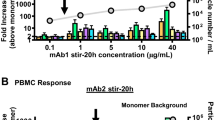Abstract
Background: Although sentinel lymph node (SLN) biopsy is a powerful staging tool for patients with melanoma and breast cancer, controversy remains regarding specific aspects of technique. We examined particle uptake by antigen-presenting cells (APCs) to determine if this mechanism is responsible for the differential retention of radioactivity in SLNs relative to nonsentinel lymph nodes (NSLNs).
Methods: Mapping was conducted in pigs injected with vital blue dye, fluoroscein isothiocyanate- labeled human serum albumin (FITC-HSA), and one of two99mtechnetium-labeled tracers, i.e., human serum albumin, a small macromolecule, or unfiltered sulfur colloid, a mixture of small and large particles. Macromolecule uptake by APCs was studied in vitro by using FITC-HSA and measured by fluorescence-activated cell sorting (FACS). SLNs and NSLNs were analyzed by fluorescence microscopy or FACS, with counterstaining for leukocyte cell surface markers.
Results: Both radiotracers were effective. Cultured APCs rapidly took up FITC-HSA. Microscopy showed FITC-HSA in the subcapsular sinus of SLNs shortly after injection and subsequent distribution to interfollicular areas. FACS revealed increasing amounts of FITC-HSA in SLNs over time. Cells responsible for uptake were APCs, expressing major histocompatibility (locus) class II.
Conclusions: This report establishes active macromolecule uptake as a mechanism that determines SLN status. This mechanism has important implications for performing SLN biopsy.
Similar content being viewed by others
References
Morton DL, Wen DR, Wong JH, et al. Technical details of intraoperative lymphatic mapping for early stage melanoma. Arch Surg 1992;127:392–399.
Giuliano AE, Jones RC, Brennan M, Statman R. Sentinel lymphadenectomy in breast cancer. J Clin Oncol 1997;15:2345–2350.
Krag D, Weaver D, Ashikaga T. The sentinel node in breast cancer. N Engl J Med 1998;339:941–946.
Morton DL, Bostick PJ. Will the true sentinel node please stand. Ann Surg Oncol 1999;6:12–14.
Kapteijn BAE, Nieweg OE, Muller SH, et al. Validation of gamma probe detection of the sentinel node in melanoma. J Nucl Med 1997;38:362–366.
Gershenwald JE, Tseng C, Thompson W, et al. Improved sentinel lymph node localization in patients with primary melanoma with the use of radiolabeled colloid. Surgery 1998;124:204–210.
Albertini JJ, Cruse CW, Rapaport D, et al. Intraoperative radiolymphoscintigraphy improves sentinel lymph node identification for patients with melanoma. Ann Surg 1996;223:217–224.
Strand S, Persson BRR. Quantitative lymphoscintigraphy. I. Basic concepts for optimal uptake of radiocolloids in the parasternal lymph nodes of rabbits. J Nucl Med 1979;20:1038–1046.
Bergqvist L, Strand S, Persson BRR. Particle sizing and biokinetics of interstitial lymphoscintigraphic agents. Semin Nucl Med 1983;13:9–19.
Nathanson DS, Anaya P, Karvelis KC, Eck L, Havstad S. Sentinel lymph node uptake of two different technetium-labeled radiocolloids. Ann Surg Oncol 1997;4:104–110.
Wong JH, Terada K, Ko P, Coel MN. Lack of effect of particle size on the identification of the sentinel node in cutaneous malignancies. Ann Surg Oncol 1998;5:77–80.
Glass EC, Essner R, Morton DL. Kinetics of three lymphoscintigraphic agents in patients with cutaneous melanoma. J Nucl Med 1998;39:1185–1190.
Bedrosian I, Scheff AM, Mick R, et al. Technetium-99m human serum albumin: an effective radiotracer for identifying sentinel lymph nodes in melanoma. J Nucl Med 1999;40:1143–1148.
Tafra L, Chua AN, Ng PC, Aycock D, Swanson M, Lannin D. Filtered versus unfiltered technetium sulfur colloid in lymphatic mapping: a significant variable in a pig model. Ann Surg Oncol 1999;6:83–87.
Czerniecki BJ, Carter C, Rivoltini L, et al. Calcium ionophoretreated peripheral blood monocytes and dendritic cells rapidly display characteristics of activated dendritic cells. J Immunol 1997;159:3823–3837.
Sallusto F, Lanzavecchia A. Efficient presentation of soluble antigen by cultured human dendritic cells is maintained by granulocyte/macrophage colony-stimulating factor plus interleukin 4 and downregulated by tumor necrosis factor a. J Exp Med 1994;179:1109–1118.
Albertini JJ, Lyman GH, Cox C, et al. Lymphatic mapping and sentinel node biopsy in the patient with breast cancer. JAMA 1996;276:1818–1122.
O’Hea BJ, Hill DK, El-Shirbiny AM, et al. Sentinel lymph node biopsy in breast cancer: initial experience at Memorial Sloan- Kettering Cancer Center. J Am Coll Surg 1998;186:423–427.
Goydos JS, Ravikumar TS, Gerimino J, Yudd A, Bancila E. Minimally invasive staging of patients with melanoma: sentinel lymphadenectomy and detection of the melanoma-specific proteins Mart-1 and tyrosinase by reverse transcriptase polymerase chain reaction. J Am Coll Surg 1998;187:182–188.
Krag DN, Meijer SJ, Weaver DL, et al. Minimal-access surgery for staging of malignant melanoma. Arch Surg 1995;130:654–658.
Borgstein PJ, Pijpers R, Comans EF, van Diest PJ, Boom RP, Meijer S. Sentinel lymph node biopsy in breast cancer: guidelines and pitfalls of lymphoscintigraphy and gamma probe detection. J Am Coll Surg 1998;186:275–283.
Ikomi F, Hanna GK, Schmid-Schonbein GW. Mechanism of colloidal particel uptake into the lymphatic system: basic study with percutaneous lymphography. Radiology 1995;196:107–113.
Picker LJ, Siegelman MH. Lymphoid tissues and organs. In: Paul WE, ed. Fundamental Immunology. New York: Raven Press, 1993:145–197.
Hill ADK, Tran KN, Akhurst T, et al. Lessons learned from 500 cases of lymphatic mapping for breast cancer. Ann Surg 1999;229:528–535.
Author information
Authors and Affiliations
Corresponding author
Rights and permissions
About this article
Cite this article
Faries, M.B., Bedrosian, I., Reynolds, C. et al. Active Macromolecule Uptake by Lymph Node Antigen-Presenting Cells: A Novel Mechanism in Determining Sentinel Lymph Node Status. Ann Surg Oncol 7, 98–105 (2000). https://doi.org/10.1007/s10434-000-0098-6
Received:
Accepted:
Issue Date:
DOI: https://doi.org/10.1007/s10434-000-0098-6




